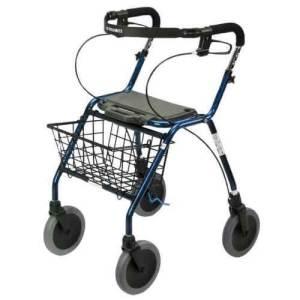If you’re living with a gait and balance impairment, this is a familiar scenario. You’re innocently walking, minding your own business, and out of nowhere an angry rogue floor knocks you down. No reason, just walking, then BOOM, down you go. Laughing about a rogue surface helps lighten an embarrassing situation, but mobility problems can impair your ability to exercise, put you at risk for sprains, bruises or worst case, breaking a bone.
Gary’s gait and balance have slowly been declining. His balance is not as bad as his gait on flat surfaces, but if he’s on uneven ground or attacked by an angry floor its impossible to stop a fall. His neurologist felt it was important he start a physical therapy program to maintain muscle strength. His PCP thought it might be time to transition from a cane to a walker.
Cerebellar degeneration or atrophy is often the underlying cause of cerebellar ataxia. The cerebellum plays a significant role in coordinating your fine motor function, gait, balance, vision, and swallowing. Cerebellar ataxia will also cause fatigue, affect your executive function, personality, mood, and increase your risk of depression.
Yes, There Will Be A Test
We see many rotating triage nurses monthly, and they’re required to chart a visual fall risk assessment at every appointment. Some never see the notation in his records of “Gait and Balance Impaired.” Some will ask, “Have you fallen recently?” Gary hates answering yes so he tends to downplay any fall. If they notice the cane but ask no questions we’ll often see “slight fall risk” recorded.
Gary went to the kinesiology unit for a balance and gait evaluation early last week. It helps to have a current test score for two reasons. The first is simple, how great is your fall risk? Your physical therapist is trained to know what assistive devices would be best suited for your case if they know what your actual fall risk score is.
The second, for superficial siderosis patients who have chosen to try chelation therapy, if your score remains constant with no worsening or if you see an improvement then it’s a good indication your Deferiprone (Ferriprox) is working.
POMA: Performance-Oriented Mobility Assessment
The performance-oriented mobility assessment (POMA).4 is also referred to as The “Tinetti Test,” for the author Mary Tinetti (Yale University). It was designed to not only give an accurate indication of subjects fall risk and maneuverability level but also produce a better predictive result on re-testing.
The test contains two sections, gait, and balance. Each part has a checklist of activities which are scored on points from 0 to 2, 0: profoundly impaired, 1: slightly impaired and 2: normal function. A standard gait test will return a maximum score of 12, and a balance will score a 16. Both section scores are added together to determine the overall test score with a maximum of 28 possible.
Tinetti Tool Score Risk of Falls
≤18 High
19-23 Moderate
≥24 Low
Mobility Aids
Gary’s PCP had suggested it may be time to consider using a walker. I’ll just say it wasn’t a welcome suggestion. When he scored a total of 15 on his test, the physical therapist asked if he would be open to trying one out. Gary later said he could feel my affirmative head nod from behind, so he agreed to have them show him how it might help. 
He now has a Dolomite Legacy 600 with a nifty little basket. We came to a compromise on when he will use it. If we go somewhere he can use a shopping buggy for balance he will still use his cane. If we go anywhere we anticipate a lot of walking, like a flea market or street fair, he will use the walker.
We had been renting a motorized scooter or borrowing a wheelchair for these type of excursions so he could keep up but since the walker has a nice seat to rest on when he needs to this will help him build up stamina. A win-win. Gary still tries to walk on our treadmill (equipped with handrails, front and sides) but now finds it’s one of the few activities that sometimes brings on a headache.
Maintaining Muscle Strength
One problem Gary does not have is the loss of strength. During every neurology evaluation, he still has excellent muscle tone, power and no sign of wasting. If it weren’t for the 10lb lifting limit because of the pseudomeningocel at the C-2/C-3 area of his neck, he could still lift weights as long as he remained seated.
Maintaining this strength is an essential part of balance and gait. We asked if there was a low impact program Gary could be taught to do at home since twice weekly two-hour trips to the hospital would be difficult. The therapist demonstrated an extensive set of exercises, adapted for Gary’s gait and balance issues, he can do on a regular schedule in our living room.
I’ll be outlining this program for everyone (with pictures) in our next post if anyone would like to try some of these exercises at home too.

